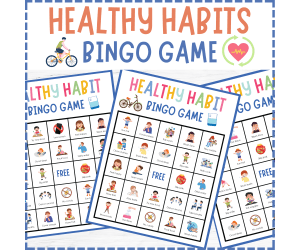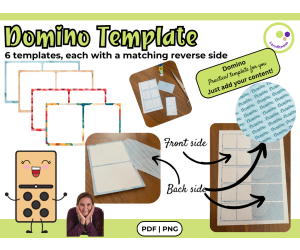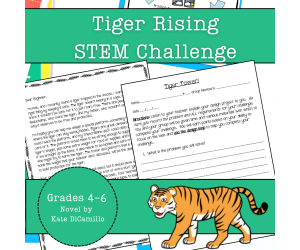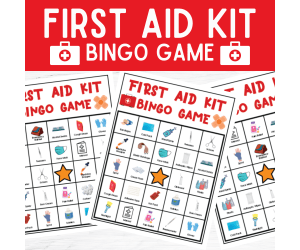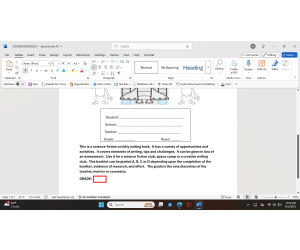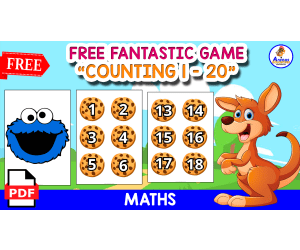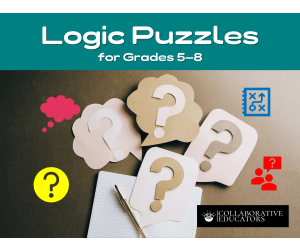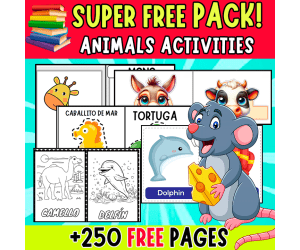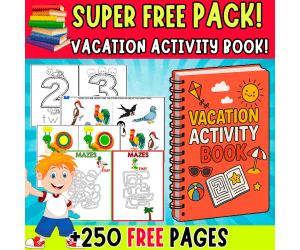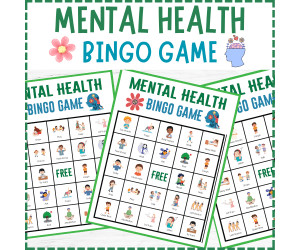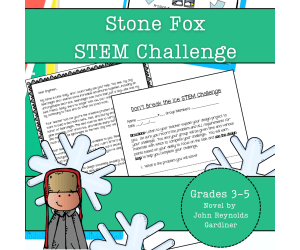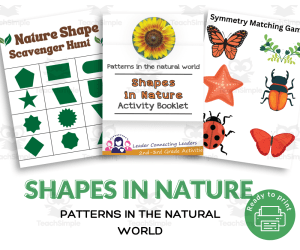2,747 products added recently
STEM Activities For Elementary
Introduce your elementary students to STEM concepts with activities designed to spark interest and understanding. This collection includes simple robotics, science experiments, and math puzzles. By incorporating these STEM activities into your teaching, you can build foundational skills and inspire a love for innovation.
Healthy Habits Bingo Game, wellness & self care classroom game
STEM, Physical Education, P.E. & Health, Health, Kindergarten, Preschool, Grade 1, 2, 3, Games, Activities
Make learning about health and wellness fun with this engaging Healthy Habits Bingo Game ! Perfect for classrooms, homeschool, health units, or kids’ wellness parties, this no-prep printable game helps teach children the importance of self-care, hygiene, nutrition, and staying active—all in a playful and memorable way. With colorful, kid-friendly visuals and everyday wellness themes like brushing teeth, drinking water, washing hands, exercising, and eating fruits and veggies, this bingo game encourages positive daily routines while keeping kids excited and involved. What’s Included In this Bingo Game File? 40 unique Healthy Habits Bingo cards Calling cards featuring health and self-care images Easy-to-follow instructions – just print and play Suitable for group games, centers, or individual review This Game Pack Is Perfect For: Health & hygiene units Social-emotional learning (SEL) activities Wellness week or school health fair Morning meetings or classroom brain breaks This Healthy Habits Bingo is a fun and interactive way to support children's well-being, build life skills, and start important conversations about self-care in the classroom or at home!
Author Perfect_Printables
Rating
Tags Healthy Habits Bingo, Health Bingo For Kids, Wellness Classroom Game, Hygiene Bingo Game, Nutrition Bingo Printable, Self Care Bingo For Kids, Healthy Habits Activity, Wellness Worksheet For Students, Printable Health Game, Hygiene Classroom Activity
GHS Pictogram Clipart – Glitter Design for Chemistry Classrooms & Craf
Common Core, Science, STEM, Chemistry, Physics, Life Sciences, Earth and Environmental Sciences, Technology, Basic Science, Resources for Teachers, Homeschool Templates, Homeschool Curriculum, Grade 10, 11, 12, Classroom Decor, Bulletin Boards, Posters, Teacher Tools, Word Walls, Door Decor, Experiments, Activities, Labs, Worksheets & Printables
GHS Pictogram Cliparts Glitter Design for Chemistry Classrooms, Crafts and Materials PNG If you’ve ever found the standard GHS (Globally Harmonized System) pictograms a bit too plain or uninspiring for your teaching materials, you’re not alone. That’s exactly why I decided to redesign them with a fresh twist. These 18 cliparts—9 in portrait and 9 in landscape format—combine the clarity of the official hazard symbols with a visually striking glitter effect. The colors remain true to the original system (red border, black symbol), but the glitter gives them a unique and eye-catching feel. I created each of these cliparts by hand in Procreate, with the classroom in mind. They’re still clearly recognizable as hazard pictograms, but they add a touch of design that fits beautifully into worksheets, posters, or digital resources. Ways you might use these in your classroom or materials: – Labeling chemical containers in a more engaging way – Gluing into student chemistry notebooks to support safety topics – Decorating posters or bulletin boards about lab safety rules – Enhancing worksheets or lab instructions visually – Adding to PowerPoint, Keynote, or Genially presentations – Integrating into digital learning platforms or safety training resources – Using them in flashcards for visual reinforcement Since you’ll receive both portrait and landscape versions (in PNG format with transparent backgrounds), you can easily adjust them to your layout or format. Whether you're printing or working digitally, the designs remain sharp and flexible. These glitter-style symbols were made to support safety awareness while also respecting visual design preferences—especially for teachers or students who appreciate a bit more flair in their materials. Usage rights: You may use the cliparts both privately and commercially within educational content, as long as your own contribution is clearly visible. Please do not resell the graphics individually. Wishing you lots of creativity while designing your materials, – Heike from @Lernfitness Did You Know? I teach with a certified therapy dog, and together we create a positive and welcoming learning environment. 🐶
Author Lernfitness
Rating
Tags Teaching Materials, Classroom Decorations, Decorative Elements, Cliparts, Illustrations, GHS, Science, Lab, Chemistry, Pictograms
Blank Domino Templates – With Matching Backs for Easy Printing
STEM, Science, Montessori, Common Core, Creative Arts, Graphic Arts, Resources for Teachers, Classroom Management, Math, Holiday & Seasonal, Grade 6, 7, 8, Activities, Games, Worksheets & Printables, Task Cards, Quizzes and Tests, Teacher Tools, Flashcards, Escape Room, Projects, Templates
Blank Domino Templates – With Matching Backs for Easy Printing A creative resource for designing your own domino games – in class or at home These printable domino templates offer a simple and flexible way to create your own domino-style learning games. Whether you’re planning a classroom activity, a subject-specific matching task, or even a commercial resource, this set makes the design process much easier. The download includes 6 ready-to-use templates, each laid out on a single A4 page in PDF format. Each domino comes with a color-matching reverse side labeled “Domino” – so once printed, you can fold and glue the sheet to create double-sided domino cards that feel polished and consistent. What’s included: 6 different blank domino layouts (PDF) Coordinated reverse sides for each template PNG versions of fronts and backs for flexible digital design Instructions for use (folding, gluing, optional laminating) Ideas for classroom use: I've used these templates in lessons where students create their own review materials. For example, after a unit on chemical elements or vocabulary sets, students design their own dominoes in pairs – matching concepts, definitions, or images. It’s a nice way to check understanding and encourage collaboration. Because the structure is already in place, the focus stays on content, not formatting. For digital or printable projects: You can insert your own content in programs like PowerPoint, Keynote, or Canva. Just add images or text boxes to the template and print. If you plan to laminate them, they’ll hold up well for repeated use. Commercial use is allowed under specific terms: the templates must be used as part of your own content, not shared in their original form. Attribution is requested (details provided in the download). A flexible tool for anyone who enjoys designing learning games – or wants to hand over the creative part to students! 📍 Best wishes, Heike from @Lernfitness Did You Know? I teach with a certified therapy dog, and together we create a positive and welcoming learning environment. 🐶
Author Lernfitness
Rating
Tags Educational Card Games, STEM Science Matching Game, Game, Domino, Differentiation, Template, Blank Domino Templates, Editable Domino Game, DIY Classroom Game, Matching Game
Stone Fox Literature Unit and STEM Challenge
ELA, Literature, STEM, Grade 3, 4, 5, Activities
This resource combines reading comprehension, vocabulary building, and a STEM challenge to create a meaningful and engaging experience for your students. Perfect for both in-person and distance learning, these activities will help your students connect deeply with the novel while practicing critical thinking skills. What's Included: Reading Journal Activities Guided journal prompts that encourage students to make predictions, analyze characters, and draw connections to the text. Vocabulary work: students choose five words from the novel to explore, reinforcing word meaning and usage. Includes rubrics to make assessing journal entries and vocabulary tasks quick and consistent. Graphic Organizers Easy-to-use organizers for analyzing characters and story elements, helping students visualize and organize their thoughts. Virtual Learning Adaptations Suggestions for completing all activities online, making this unit a flexible choice for distance learning or hybrid classrooms. STEM Challenge: Build a Sled Bring the story to life with a hands-on engineering activity. Students design and construct a sled capable of carrying weight across a simulated ice surface without sinking or breaking through. Includes guidance for introducing the engineering design process and encouraging problem-solving and teamwork. This Stone Fox literature unit gives you everything you need to integrate reading, writing, and STEM into one cohesive experience. Whether you’re teaching this classic story for the first time or looking to refresh your approach, this resource will engage your students and make learning memorable. Keywords: Stone Fox literature unit, Stone Fox STEM project, reading journal prompts, vocabulary activities, character analysis organizer, story elements graphic organizer, distance learning novel study, STEM sled design challenge, upper elementary literature activities, cross-curricular reading unit.
Author Kel's Klass
Tags Novel Study, Stone Fox, Story Elements, Reading Journal, STEM Challenge, Stone Fox Genre, Stone Fox Vocabulary
Tiger Rising STEM Experiment + STEM Project for Grades 4, 5, 6
Science, Technology, Engineering, STEM, Grade 4, 5, 6, Experiments, Activities, Projects, Diagrams, Teacher Tools, Graphic Organizers, Rubrics
This hands-on activity combines creativity and problem-solving as students design and build a tower for the safety of the tiger in the novel, Tiger Rising. Perfect for integrating literature and science, this challenge encourages students to apply engineering principles using simple materials while fostering teamwork and critical thinking. What’s Inside This Resource: Student Letter: A letter from Rob Horton introduces the challenge, linking the story to a real-world engineering task. Design Loop Graphic: A visual students can attach to their science journals, serving as a step-by-step guide throughout the activity. Detailed Instructions: Choose to print the guide as a packet or have students record each stage in their journals for an interactive experience. Teacher Tips: Practical guidance for crafting a clear problem statement with time constraints, materials, and success criteria tailored to your classroom. Skills Your Students Will Build: ✔ Problem-Solving: Identify obstacles and create inventive solutions. ✔ Engineering Design: Navigate the design loop—plan, construct, test, and refine. This page can easily be enlarged for a classroom poster. ✔ Critical Thinking: Assess their prototype’s performance and pinpoint ways to enhance it. ✔ Teamwork: Collaborate effectively to accomplish shared goals. Versatile Classroom Application: Whether as guided instruction or part of an integrated literature and science unit, this STEM activity encourages students to think creatively, document their process, and meet science and engineering standards. The rubric included is based on engineering concepts, but can also be used as a nonfiction writing rubric for cross-curricular options. Why Educators Love This Resource: ⭐ “My students were fully engaged, combining their passion for reading with STEM!” ⭐ “Simple to set up and encourages creativity and teamwork.” ⭐ “A seamless connection between literature and science for cross-curricular learning!” Encourage your students to provide a safe haven for the tiger (and Rob and Sistine?) and experience the excitement of engineering with this standards-aligned STEM adventure!
Author Kel's Klass
Tags 4th Grade Science Project, 4th Grade Science Experiment, 5th Grade Science Project, 5th Grade Science Experiment, 6th Grade Science Project, 6th Grade Science Experiment, Engineering Diagram, Science Graphic Organizer, Science Rubric, Tiger Rising
Mathematics Binder Covers – Templates for Classroom Use
Science, STEM, Basic Science, Special Resources, Montessori, Classroom Management, Resources for Teachers, Math, Physics, Technology, Homeschool Templates, Grade 6, 7, 8, 9, Worksheets, Worksheets & Printables, Teacher Tools, Projects, Activities, Workbooks, Drawing Templates & Outlines, Templates, Graphic Organizers, Classroom Decor
Mathematics Binder Covers – Templates for Classroom Use Organize your Math handouts, notes, and units with visual clarity Simple and flexible templates to help organize your Mathematics materials In my math classes, it can be a challenge to keep things organized - especially when it comes to multiple units, lab notes, worksheets and review materials. To make it easier for my students and myself, I designed these simple binder sleeves. There are 12 different pages. The covers have a clean, colorful blob layout that is friendly but not distracting. I usually print them out and use them as cover sheets or as dividers in folders for students or teachers. They also work well for digital learning environments, e.g. as section covers in PDF files or on classroom platforms. I like that the color scheme allows students to quickly find what they are looking for, and it brings a little more structure to a subject that is often riddled with formulas and technical terms. When used as cover sheets, students can choose their favorite color for their cover sheet. This resource is handy - and has saved me a lot of time in lesson preparation and follow-up. What’s included: 12 math-themed cover pages different colors zu choose as a cover sheet as a divider between the individual Mathematics topics I've printed these on colored paper for my own binder and also used them digitally in student notebooks. Works well for both teacher organization and student-facing materials. 📍 Best wishes, Heike from Lernfitness Math teacher (Chemistry teacher, Biology teacher) in Germany Did You Know? I teach with a certified therapy dog, and together we create a positive and inspiring learning environment. 🐶✨
Author Lernfitness
Rating
Tags Science, STEM, Binder, Cover Sheet, Template, Organizer, Organize, GoodNotes, Mathematics, Math
First Aid Kit Bingo Game | First Aid & Emergency Safety Activity
STEM, Life Studies, Kindergarten, Preschool, Grade 1, 2, 3, Games, Activities
Teach kids about safety in a fun and memorable way with this First Aid Kit Bingo Game ! Designed especially for young learners, this interactive game introduces important first aid items and emergency safety vocabulary through play-based learning. With clear visuals and easy-to-understand terms like "bandage," "thermometer," "gloves," and "ice pack," children will become familiar with basic first aid tools while improving listening and matching skills. It’s a great resource to use during health and safety units, community helper lessons, or school safety week. What’s Included In this Bingo game pack? 40 unique First Aid Bingo cards 30 Calling cards featuring first aid kit items and safety tools Simple instructions for individual, group, or class play Printable format for easy prep—just print and go! This Game is Perfect For: Health and safety lessons Emergency preparedness activities Community helper units Classroom centers or homeschool learning Make safety education fun, interactive, and engaging with this First Aid Kit Bingo Game—a great way to start important conversations while keeping students involved and learning!
Author Perfect_Printables
Rating
Tags First Aid Kit Bingo, First Aid Bingo Game, Emergency Safety Activity, Safety Bingo For Kids, Health And Safety Game, First Aid Worksheet For Kids, Printable Safety Game, Emergency Kit Activity, Community Helpers Activity
SCIENCE FICTION, IMAGINATION AND CREATIVITY
Science, STEM, Technology, Physics, Research, Common Core, Creative Arts, Art, Basic Science, Chemistry, Grade 5, 6, 7, 8, Worksheets & Printables, Activities, Centers
This booklet contains diverse activities and a welcoming of students to engage in this genre of sci-fi writing. Sometimes, science fiction does play a role into realization. It is recommended for upper elementary, middle school and MG students. There is a required reading segment, an assignment that includes writing 10 sci fi stories. Included in this booklet is a word search, deciphering activity, creation of a science fiction cartoon, designing an invention on paper. . Moreover, there is a vocabulary segment, some art, and the importance of inserting some actual science text into this type of writing. There are 2 answer keys included. There is a portion for teacher's comments on the 10 stories. It is 40 pages. There are quotes from famous writers/ scientists. This is a pdf booklet. There are several common core standards covered in this booklet such as developing analytic skills, deiphering text relative to science, and more importantly the development of an inquisitive, imaginative mind. Einstein has reminded us the imagination is more important than knowledge. knowledge is limited!
Author THE LANTERN OF KNOWLEDGE
Rating
Tags ASTRONOMY, SPACE, PLANETS, GRAVITY
FREE GAME | COUNTING NUMBERS 1 - 20
Math, Special Resources, STEM, Early Learning, Elementary, Pre-K, Activities, Worksheets & Printables
COUNTING NUMBERS 1 - 20 Hello! I thank you infinitely for your interest in my educational store! I am a teacher who strives every day to produce these great educational resources for children, so I thank you because with your downloads you are helping a lot to promote my personal and professional work. MAIN INFORMATION: 1. Why should teachers use educational material in the classroom? As is known, educational material helps students build their knowledge autonomously and, above all, in an unforgettable way. 2. What is the name of this document? This document is titled "Educational material for children" 3. What topic will be addressed in this resource? This document will address an educational topic that every child should learn in a basic way. 4. For what ages is it recommended? This set of educational sheets is recommended for children in general who are in the learning age and these sheets will be of great help to them. 5. Who is the author of this document? The author, who was in charge of producing and compiling this educational material, is EDITORIAL ARENAS EDUCATIVAS. 6. In what area of knowledge can it be applied? You can apply this set of educational sheets according to your criteria, in the corresponding area. SECONDARY INFORMATION: 7. Aimed at children of ages: This educational document is specifically aimed at children in primary education. 8. Area: This educational document may be used in some area of primary education for children. 9. Keywords: children, primary education, resources for children, free resources, primary resources, resources for primary education. 10. How do I print it? You can print this document in PDF format, A4 size. 11. How to apply it in class? You can apply this document individually or also in a group, it all depends on the criteria of the educator who is going to apply this sheet. 12. Will they need extra elements to use this sheet? Yes, perhaps the students when using this sheet will need pencils, colors, or perhaps scissors, eraser. It all depends on the point of view of the educator.
Author EDITORIAL LAURA EDUCA
Tags FREE GAME, COUNTING NUMBERS, COUNTING, MATHS, FREE RESOURCES, MATH RESOURCES
ABC COLORING MINIBOOK | ANIMAL FREE THEMED
Writing, ELA, Creative Arts, STEM, Adult Education, Early Learning, Elementary, Homeschool Resources, High School, Middle School, Not Grade Specific, Pre-K, Activities, Teacher Tools, Classroom Decor, Worksheets & Printables
ABC COLORING MINIBOOK | ANIMAL FREE THEMED THIS RESOURCE IS PERFECT FOR COLORING AND LEARNING THE ABC! ENJOY IT. PLEASE, DOWNLOAD FREE THIS RESOURCES TOO: IDENTIFY THE FRUIT: https://teachsimple.com/product/identify-the-fruit-4-free-flashcards PAINTING SHAPES: https://teachsimple.com/product/painting-shapes-4-free-worksheets DIFFERENT ICON: https://teachsimple.com/product/the-different-icon-6-free-worksheets DESCRIPTION OF THIS PRODUCT: 1) What is a brief synopsis of the content of this resource? This educational document has been developed for children's learning, especially in an educational and engaging way, because, as is well known, children learn best with fun materials. 2) How is this product described in detail? This educational document contains worksheets for children. They can be in either color or black and white. The way you print them is up to you, so evaluate this worksheet before printing it, that is, make sure it suits your needs. 3) What advantages does using this material offer? This document offers various advantages, such as: - It will help your children and/or students learn in a better or more fun way. - It will foster your students' creativity. - It will motivate your students and/or children to learn more independently. - Also, remember that you can use this material both at home and in class. 4) How many pages are in this document in total? SECONDARY AND COMPLEMENTARY INFORMATION: 1) What version does this document correspond to? This educational resource is designed in PDF format, which will make your download experience much simpler and easier to use. 2) Is the material designed in color or black and white? This document has been designed in color (if required) or is sometimes created in black and white to make your learning experience easier. 3) What age range is appropriate for this resource? Our publishing company is dedicated to creating resources for young children between the ages of 3 and 12, as well as for older students or anyone who needs them. 4) What keywords best describe this resource? We can tag this product with keywords such as: teaching resource, resources, materials, teaching materials, worksheets, educational worksheets, worksheets for children.
Author EDITORIAL LAURA EDUCA
Rating
Tags FREE, FREE RESOURCES, ALPHABETH, ABC, ABECEDARY, COLORING, PAINTING, COLORING PAGES
20 Logic Puzzles for Grades 5-8
STEM, Math, Science, Grade 5, 6, 7, 8, Games, Activities, Quizzes and Tests, Teacher Tools, Quizzes, Word Problems, Worksheets & Printables
Unlocking Logic: 20 Engaging Puzzles for Grades 5–8 is an entertaining and difficult set of brainteasers created to help middle school students improve their reasoning, critical thinking, and problem-solving abilities. There are 20 different puzzles in this ebook, such as logic grids, magic squares, numerical patterns, riddles, code-breaking, spatial thinking, and more. Every puzzle is designed to pique students' interest and promote original thought, which makes it ideal for early finishers, homework, enrichment, and classroom use. In order to engage a diverse variety of learners and facilitate flexible use across grades 5–8, the puzzles vary in difficulty and style. Pupils are urged to work alone or in groups, experiment with different approaches, and develop resilience by tackling problems carefully. To facilitate guided conversation and self-checking, a complete answer key is supplied. Whether you're a teacher looking to inspire your class or a parent wanting to support logical thinking at home, this ebook is the perfect companion for building sharp minds—one puzzle at a time!
Author Bright Classroom Ideas Marketplace
Rating
Tags Riddle, Logic, Puzzle, Quiz, Grade 5
CONNECT THE DOTS | 10 FREE PICTURES FOR KIDS
Special Resources, STEM, ELA, Handwriting, Writing, Early Learning, Elementary, Pre-K, Activities, Worksheets & Printables
10 FREE EXERCISES FOR CONNECT DOTS INTRODUCTION: We are EDITORIAL ARENAS EDUCATIVAS, a publisher dedicated to designing educational resources for primary school children approximately between the ages of 3 and 12 who are learning mathematics, literacy, as well as worksheets for learning Spanish and some brain exercises. MAIN INFORMATION: 1. Brief introduction: Hello, thank you very much for being interested in this educational document. This document will help you a lot both in the classroom if you are a teacher, as well as if you homeschool and want to stimulate your children from home. 2. Title of the educational resource: This document is titled "Teaching material for children" 3. Topic to work on: Thanks to this educational document, we are going to work on a basic topic that every child and/or student should master. 4. Area of knowledge where it should be applied: Thanks to this document, we will address a topic and at the same time an important area of learning. 5. Number of pages it contains: This educational document contains the following number of pages available and ready to be used by you, you just have to download and print the document to start using it in your classroom. SECONDARY INFORMATION: 6. In what area of knowledge can it be applied? You can apply this set of educational sheets according to your criteria, in the corresponding area. 7. Should I apply it individually or as a group in my class? Also, according to your criteria, see if it is better for these sheets to be applied individually or as a group. 8. What size and format is this resource in? This set of teaching sheets has been published in A4 size, PDF format, so that it is much easier to use. 9. Do I need any extra elements to apply it? Yes, perhaps your students need pencils, colors, markers and even sometimes scissors and erasers.
Author EDITORIAL LAURA EDUCA
Tags DOTS, CONNECT THE DOTS, HANDWRITING, FREE RESOURCES, FREE
SUPER FREE PACK | +250 PAGES | ANIMALS ACTIVITIES FOR KIDS
Animals, Life Sciences, Science, Creative Arts, Special Resources, STEM, Early Learning, Elementary, Homeschool Resources, Pre-K, Not Grade Specific, Worksheets, Worksheets & Printables, Workbooks, Drawing Templates & Outlines, Coloring Pages, Projects, Activities
SUPER FREE PACK | +250 PAGES | ANIMALS ACTIVITIES FOR KIDS THIS SUPER PACK OF ACTIVITIES HAVE MORE THAN 250 PAGES WITH ANIMALS FUNNY ACTIVITIES. INFORMATION OF THE AUTHOR: Welcome to EDITORIAL ARENAS EDUCATIVAS! We specialize in producing diverse educational tools to support children's learning journeys. Be sure to browse our store for reading, writing, math, and Spanish resources designed to make learning fun and impactful. MAIN DESCRIPTION OF THIS PRODUCT: 1) What age ranges is this resource designed for? This document is designed for children in pre-kindergarten and elementary school. It is simply intended for children in elementary school, but it is also freely available to other grades who may need this document. 2) What version or edition does this material correspond to? This document is designed in PDF format so you can print and use it much more quickly. 3) What is the recommended printing method for this resource? I recommend printing this document in PDF format so you won't experience any errors when printing. 4) What educational standards were used as the basis for creating this material? This document was not developed based on any specific standard. SECONDARY AND COMPLEMENTARY INFORMATION OF THIS RESOURCE: 1) What age range is appropriate for this resource? Our publishing company is dedicated to creating resources for young children between the ages of 3 and 12, as well as for older students or anyone who needs them. 2) What keywords best describe this resource? We can tag this product with keywords such as: teaching resource, resources, materials, teaching materials, worksheets, educational worksheets, worksheets for children. 3) What instructions should I follow for proper printing? I recommend that you first download this document, then check if your printer is capable of printing, and also verify that you have the appropriate document size. 4) How can this resource be implemented in the classroom? You can print this document and use it first both in the classroom and at home. You can also use it individually and in groups.
Author EDITORIAL LAURA EDUCA
Rating
Tags FREE, FREE RESOURCES, SUPER PACK, PACK, BUNDLES, ACTIVITIES, ANIMALS, ANIMALS ACTIVITIES, BEST RESOURCES, TOP RESOURCES
38 POSTERS OF ANIMALS | IN ENGLISH
Phonics, Language Development, ELA, Spelling, Vocabulary, STEM, Science, Animals, Life Sciences, Early Learning, Elementary, Homeschool Resources, Not Grade Specific, Pre-K, Activities, Teacher Tools, Flashcards, Worksheets & Printables
38 POSTERS OF ANIMALS | IN ENGLISH THIS RESOURCE HAVE 38 POSTERS OF ANIMALS. INTRODUCTION: resources that help children learn and grow. We invite you to explore our full store and discover a wide range of materials. You'll find resources for reading, writing, math, and Spanish language development! MAIN DESCRIPTION: 1) What is the recommended printing method for this resource? I recommend printing this document in PDF format so you won't experience any errors when printing. 2) What educational standards were used as the basis for creating this material? This document was not developed based on any specific standard. 3) Who is the creator of this resource and how should it be cited? The creator of this document is EDITORIAL ARENAS EDUCATIVAS. 4) Is this resource available for free or does it require a purchase? Because we vocationally work for the education of thousands of students, we are offering this document for free. 5) This resource is for individual use only; what restrictions apply to its redistribution or sale? We ask that you share our link so more people can download our resource or recommend our store. It would help us greatly. SECONDARY AND COMPLEMENTARY INFORMATION: 1) How many pages does the file contain in total? This educational document contains enough pages to make this resource ideal for promoting fun and successful learning. 2) Does this material allow for custom editing? This educational document is available in PDF format, so you cannot edit it. You simply need to download and then print it. 3) What main topic does the resource cover? This document has been developed to address a basic topic that children in kindergarten through elementary school should master. This document will also be helpful to the general public who want to learn. TAGS: FLASHCARDS,ANIMALS,FREE,FREE RESOURCES,POSTERS.
Author EDITORIAL LAURA EDUCA
Rating
Tags FREE, FREE RESOURCES, ANIMALS, POSTERS, FLASHCARDS, ANIMAL POSTERS
ABC PUZZLES MINIBOOK | FREE RESOURCE FOR KIDS
ELA, Creative Arts, STEM, Special Resources, Elementary, Early Learning, Homeschool Resources, Not Grade Specific, Pre-K, Activities, Worksheets & Printables
ABC PUZZLES MINIBOOK | FREE RESOURCE FOR KIDS MAIN DESCRIPTION OF THIS PRODUCT: 1) What specific skills are developed using this resource? Students will be able to develop their attention, concentration, creativity, and imagination skills. It will also allow students to develop their cognitive skills such as comprehension, analysis, and others. 2) Who is the ideal audience for this document? This document and/or teaching resource is primarily intended for young students, meaning those between the ages of 5 and 12, in other words, students in early childhood and/or primary education. However, it can also be used by the general public if required. 3) What recommendations are there for making the most of this resource? To make the most of this resource, I recommend first analyzing it, then looking at the specific topic your student needs to learn and assess whether my resource addresses it. I also ask you to consider how you will print it. 4) Is this material up to date with the latest educational changes? Yes, this aterial primarily addresses all learning theories about children, which tell us that children should learn in an educational and fun way. SECONDARY AND COMPLEMENTARY INFORMATION: 1) Is the material designed in color or black and white? This document has been designed in color (if required) or is sometimes created in black and white to make your learning experience easier. 2) What age range is appropriate for this resource? Our publishing company is dedicated to creating resources for young children between the ages of 3 and 12, as well as for older students or anyone who needs them. 3) What keywords best describe this resource? We can tag this product with keywords such as: teaching resource, resources, materials, teaching materials, worksheets, educational worksheets, worksheets for children. 4) What instructions should I follow for proper printing? I recommend that you first download this document, then check if your printer is capable of printing, and also verify that you have the appropriate document size. 5) How can this resource be implemented in the classroom? You can print this document and use it first both in the classroom and at home. You can also use it individually and in groups. TAGS: Free,free resources,alphabet,puzzles. OTHERS FREE RESOURCES FOR YOU: ANIMAL SHADOWS: https://teachsimple.com/product/animal-shadows-1-free-worksheet SPANISH FRUITS: https://teachsimple.com/product/spanish-fruits-12-free-flashcards
Author EDITORIAL LAURA EDUCA
Rating
Tags FREE, FREE RESOURCES, ALPHABET, TRACING, TRACING LETTERS, MINIBOOK
VACATION ACTIVITY BOOK | SUPER FREE PACK
Special Resources, STEM, Early Learning, Elementary, Not Grade Specific, Homeschool Resources, Pre-K, Worksheets & Printables, Activities, Teacher Tools
VACATION ACTIVITY BOOK | SUPER FREE PACK INFORMATION OF THE AUTHOR: At EDITORIAL ARENAS EDUCATIVAS, we specialize in designing high-quality educational materials. We want every child to discover that learning can be both entertaining and creative. I invite you to explore my educational store and discover the wide collection of resources available for your classroom or home. MAIN DESCRIPTION OF THIS SUPER PACK OF ACTIVITIES: What is the name of your product and what makes it special? This beautiful product is called “VACATION ACTIVITY BOOK" and it is very special because it was carefully designed or compiled. With this educational resource, we want students to learn with enthusiasm and fun, because we believe learning is fun. How many pages are included in this resource? This fabulous document contains the following number of pages: 265 What size is it designed in (A4, letter, etc.)? This resource is designed in A4 format and compiled as a PDF. This makes downloading and printing simple and convenient, and PDFs are also easy to store and carry anywhere. PDF A4 Is the material in color or black and white? This pedagogical document comes in both black and white and color. This makes it more attractive for your learning sessions, but you have the freedom to choose how to print it. COLOR SUMMARY OF THIS RESOURCE: The name of the document: SUPER BUNDLE OF ACTIVITIES The total number of pages: 265 The format (PDF, Word, PPT): PDF Whether it is in color or black and White: COLOR SECONDARY AND COMPLEMENTARY INFORMATION: What learning area does it focus on? This and all my resources focus on children’s essential learning, such as math and literacy. Occasionally, I also create resources for Spanish. What will students learn or practice with it? With this educational resource, children will be able to practice basic skills in math and literacy. Teachers can also adapt it to other learning areas, since learning is multidisciplinary. Who will benefit the most from this resource (teachers, families, students, therapists)? I strongly believe education involves many people—teachers, parents, and even therapists. That’s why this resource is open to anyone involved in the learning process.
Author EDITORIAL LAURA EDUCA
Rating
Tags FREE, FREE RESOURCES, BUNDLE, PACK, ACTIVITY PACK, FREE PACK, PREK, KINDER, TOP RESOURCES
Science Tools & Lab Safety Bingo Game Printables
STEM, Chemistry, Science, Classroom Management, Resources for Teachers, Elementary, Pre-K, Homeschool Resources, Projects, Activities
Bring excitement and hands-on learning to your science classroom with this engaging Science Tools Bingo Game ! Perfect for elementary and middle school students, this printable bingo game is a fun way to introduce or review important lab tools, chemistry equipment, and lab safety rules in a memorable way. With colorful, kid-friendly images of beakers, goggles, test tubes, lab coats, thermometers, Bunsen burners, and more—students will build science vocabulary while playing a game they love. Great for science labs, STEM days, or a mad scientist-themed party! What’s Included In This Bingo Pack ? 30 unique Science Tools Bingo cards Calling cards with clear images and science-related terms Easy-to-follow instructions – just print and play Perfect for individual, small group, or class-wide use This Pack is Perfect For: Science lab introductions Chemistry units or STEM weeks Mad scientist day or classroom parties Lab safety and equipment review Homeschool or co-op science lessons Turn your classroom into an exciting learning lab with this Science Tools Bingo Game—a fun, no-prep way to reinforce lab safety and spark curiosity about the world of science!
Author Perfect_Printables
Rating
Tags Science Tools Bingo, Chemistry Bingo Game, Mad Scientist Bingo, Science Lab Safety Game, Science Classroom Activity, Science Bingo Printable, Lab Equipment Bingo, Stem Bingo Game, Science Party Game, Classroom Science Game
Mental Health Bingo, Self Care, Self-Esteem Bingo Game Printable
STEM, Mental Health, P.E. & Health, Mindfulness, Kindergarten, Preschool, Grade 1, 2, 3, Games, Activities
Support your students' emotional well-being with this thoughtful and engaging Mental Health Bingo Game —a printable resource designed to promote positive self-esteem, self-care habits, and healthy coping skills in a fun, age-appropriate way. Perfect for classrooms, counseling groups, SEL lessons, or mental health awareness days, this bingo game encourages meaningful conversations around emotions, self-awareness, and personal growth. With calming visuals and empowering prompts like “Take a deep breath,” “Talk to a friend,” “Get some rest,” and “Say something kind,” kids learn how to manage feelings and practice wellness in daily life. What’s Included In this Bingo Game Pack? 40 unique Mental Health Bingo cards 30 Calling cards with positive habits, coping tools, and self-esteem boosters Easy-to-use instructions – just print and play Great for individual, small group, or whole class use This Game Pack Is Perfect For: Social-Emotional Learning (SEL) lessons School counseling sessions Classroom wellness corners Mental health awareness events Self-care or mindfulness activities This Mental Health Bingo makes it easy to bring empathy, encouragement, and healthy habits into your classroom while helping students build lifelong emotional resilience. 💚🧠🌈
Author Perfect_Printables
Rating
Tags Mental Health Bingo, Self Care Bingo, Self Esteem Bingo, Coping Skills Bingo, Wellness Bingo Printable, Mindfulness Activity For Kids, Social Emotional Learning Game, Mental Health Activity, Coping Skills Worksheet, Self Care Classroom Game
Stone Fox STEM Experiment + STEM Project for Grades 3, 4, 5
Science, Technology, Engineering, STEM, Grade 3, 4, 5, Experiments, Activities, Projects, Diagrams, Teacher Tools, Graphic Organizers, Rubrics
Little Willy is looking for a way to build a sled that will honor Searchlight, in this STEM project inspired by Stone Fox. This science project encourages problem-solving as students plan and construct a sled that will be able to carry Willy safely across a block of ice. Perfect for blending literature with science, it allows students to explore engineering concepts using simple supplies while promoting teamwork and critical thinking. What’s Inside This Resource: Student Letter: A heartfelt letter from Little Willy introduces the challenge, linking the story to a real-world engineering task. Design Loop Graphic: A visual students can attach to their science journals, serving as a step-by-step guide throughout the activity. Detailed Instructions: Choose to print the guide as a packet or have students record each stage in their journals for an interactive experience. Teacher Tips: Practical guidance for crafting a clear problem statement with time constraints, materials, and success criteria tailored to your classroom. Skills Your Students Will Build: ✔ Problem-Solving: Identify obstacles and create inventive solutions. ✔ Engineering Design: Navigate the design loop—plan, construct, test, and refine. This page can easily be enlarged for a classroom poster. ✔ Critical Thinking: Assess their prototype’s performance and pinpoint ways to enhance it. ✔ Teamwork: Collaborate effectively to accomplish shared goals. Versatile Classroom Application: Whether as guided instruction or part of an integrated literature and science unit, this STEM science project encourages students to think creatively, document their process, and meet science and engineering standards. The rubric included is based on engineering concepts, but can also be used as a nonfiction writing rubric for cross-curricular options. Why Educators Love This Resource: ⭐ “My students were fully engaged, combining their passion for reading with STEM!” ⭐ “Simple to set up and encourages creativity and teamwork.” ⭐ “A seamless connection between literature and science for cross-curricular learning!” Encourage your students to help Little Willy achieve his goals and experience the excitement of engineering with this standards-aligned STEM adventure!
Author Kel's Klass
Tags 4th Grade Science Project, 4th Grade Science Experiment, 5th Grade Science Project, 5th Grade Science Experiment, Engineering Diagram, Science Graphic Organizer, Science Rubric, 3rd Grade Science Project, 3rd Grade Science Experiment, Stone Fox
ABC MNIBOOK | 26 FREE PAGES | FLOWER THEMED
Creative Arts, Writing, ELA, Handwriting, STEM, Special Resources, Elementary, Homeschool Resources, Not Grade Specific, Pre-K, Activities, Worksheets & Printables
ABC MNIBOOK | 26 FREE PAGES | FLOWER THEMED INTRODUCTION: Welcome to EDITORIAL ARENAS EDUCATIVAS! We specialize in producing diverse educational tools to support children's learning journeys. Be sure to browse our store for reading, writing, math, and Spanish resources designed to make learning fun and impactful. OTHERS FREE RESOURCES FOR YOU: DOT-DOT ACTIVITY: https://teachsimple.com/product/dot-dot-activity-4-free-pages DRAWING THE MODEL: https://teachsimple.com/product/drawing-models-6-free-pages TRACING LINES: https://teachsimple.com/product/tracing-lines-and-strokes-4-free-pages DESCRIPTION OF THIS PRODUCT: 1) Who is the ideal audience for this document? This document and/or teaching resource is primarily intended for young students, meaning those between the ages of 5 and 12, in other words, students in early childhood and/or primary education. However, it can also be used by the general public if required. 2) What recommendations are there for making the most of this resource? To make the most of this resource, I recommend first analyzing it, then looking at the specific topic your student needs to learn and assess whether my resource addresses it. I also ask you to consider how you will print it. 3) Is this material up to date with the latest educational changes? Yes, this material primarily addresses all learning theories about children, which tell us that children should learn in an educational and fun way. COMPLEMENTARY INFORMATION: 1) Does this material allow for custom editing? This educational document is available in PDF format, so you cannot edit it. You simply need to download and then print it. 2) What main topic does the resource cover? This document has been developed to address a basic topic that children in kindergarten through elementary school should master. This document will also be helpful to the general public who want to learn. 3) What version does this document correspond to? This educational resource is designed in PDF format, which will make your download experience much simpler and easier to use. 4) Is the material designed in color or black and white? This document has been designed in color (if required) or is sometimes created in black and white to make your learning experience easier.
Author EDITORIAL LAURA EDUCA
Rating
Tags ALPHABET, MINIBOOK, TRACING, TRACING LETTERS, ABC, ABECEDARY, FREE, FREE RESOURCES
CONNECT THE DOTS | NUMBERS 1 TO 10
Math, Special Resources, STEM, Montessori, Early Learning, Elementary, High School, Middle School, Homeschool Resources, Not Grade Specific, Adult Education, Pre-K, Activities, Worksheets & Printables, Teacher Tools
CONNECT THE DOTS | FREE RESOURCE INTRODUCTION: We are EDITORIAL ARENAS EDUCATIVAS, a publisher dedicated to designing educational resources for primary school children approximately between the ages of 3 and 12 who are learning mathematics, literacy, as well as worksheets for learning Spanish and some brain exercises. MAIN INFORMATION: 1. Brief introduction: Hello, thank you very much for being interested in this educational document. This document will help you a lot both in the classroom if you are a teacher, as well as if you homeschool and want to stimulate your children from home. 2. Title of the educational resource: This document is titled "Teaching material for children" 3. Topic to work on: Thanks to this educational document, we are going to work on a basic topic that every child and/or student should master. 4. Area of knowledge where it should be applied: Thanks to this document, we will address a topic and at the same time an important area of learning. 5. Number of pages it contains: This educational document contains the following number of pages available and ready to be used by you, you just have to download and print the document to start using it in your classroom. COMPLEMENTARY INFORMATION: 6. Color or black/white: This educational product is designed in color because we believe that this will be much more attractive for your children. 7. Aimed at children of ages: This educational document is specifically aimed at children in primary education. 8. Area: This educational document may be used in some area of primary education for children. 9. Keywords: children, primary education, resources for children, free resources, primary resources, resources for primary education. 10. How do I print it? You can print this document in PDF format, A4 size. 11. How to apply it in class? You can apply this document individually or also in a group, it all depends on the criteria of the educator who is going to apply this sheet.
Author EDITORIAL LAURA EDUCA
Tags CONNECT THE DOTS, DOTS, FREE, FREE RESOURCES, COLORING, PAINTING, DRAWING
Life Cycle of a Pea Plant Worksheet - Plant Science Unit Study Pack
Montessori, Nature & Plants, Life Sciences, Science, Biology, STEM, Kindergarten, Preschool, Grade 1, 2, 3, Projects, Activities, Posters, Classroom Decor, Flashcards, Worksheets & Printables, Parts of and Anatomy of
Let’s learn more about amazing life of a pea plant with our worksheet! This fun and easy-to-use worksheet pack is perfect for introducing students to the stages of a plant’s growth. From tiny seed to blooming plant, kids will explore how pea plants grow, develop, and produce food. What’s You Will Get with This Study Pack? Plant Overview: A short and clear introduction to pea plants, including where they grow and why they’re important. Life Cycle Diagram: A colorful and labeled chart that shows the full journey—from seed, sprout, and seedling to mature plant. Cut-and-Paste Activity: An interactive way for students to practice sequencing the life stages. Flashcards: Helpful visual aids for remembering each part of the plant life cycle. Bonus Coloring Page: A relaxing, creative activity to reinforce learning. This Worksheet Is Ideal For: Plant science and biology units Spring-themed classroom lessons Homeschool gardening studies Hands-on centers and quiet learning activities Your Learning Goals: Identify each stage of the pea plant’s life cycle Understand how seeds grow into food-producing plants Build sequencing and observation skills through fun and interactive tasks This resource brings plant science to life and helps kids see how amazing and important plants really are!
Author Perfect_Printables
Rating
Tags Pea Plant , Life Cycle, Plant Science Unit, Life Cycle Printables, Nature Study For Kids, Botany Unit, Legume Plant Growth, Seed To Plant Stages, Science Printables, Classroom Plant Unit
Discovering Geometry in Nature: An Activity Booklet
STEM, Grade 2, 3, Games, Activities
This activity booklet is a fantastic resource for exploring the amazing shapes, patterns, and geometry found in nature. It was specifically designed to help girls earn the Brownie Shapes in Nature badge, but it's also perfect for Frontier Girl leaders working on similar achievements. Teachers and homeschooling families will find it a wonderful tool for engaging students with hands-on, outdoor learning. The booklet will guide you through fun activities like scavenger hunts, making crafts from natural materials, playing games, and even creating your own scientific graphs. It's an exciting journey to uncover the hidden geometry all around you! What's Inside? Explore Natural Objects Go on a nature scavenger hunt to discover how basic shapes—circles, squares, and triangles—appear in the natural world. You'll solidify your knowledge by playing a shape memory game and creating a unique craft using leaves and stamps. Visualize Your Findings Put on your scientist hat! Learn how to sort nature objects, tally shapes you find using a map, and play a fun game where you locate objects in nature based on their visual descriptions. A World of Symmetry Dive into the concept of symmetry. You'll match symmetrical objects, learn about symmetrical animals, and challenge yourself by building symmetrical puzzles. Finding Spirals and Patterns Uncover the incredible patterns that exist everywhere in nature. Activities include a pattern sort, a fast-paced race to recognize patterns, and an opportunity to make your own tessellation art. Become a Bird Expert This section encourages you to become a skilled bird watcher. You'll learn to observe different birds using homemade binoculars, play a game to learn more about bird parents, and practice spotting birds in their natural habitats.
Author Leader Connecting Leaders
Rating
Tags Nature, Stem, Math In Nature
10 TANGRAM EXERCISES | FREE MATH RESOURCE
Math, Geometry, Montessori, Resources for Teachers, Special Resources, STEM, Elementary, Early Learning, Homeschool Resources, Not Grade Specific, Pre-K, Activities, Teacher Tools, Worksheets & Printables
10 TANGRAM EXERCISES | FREE MATH RESOURCE THIS RESOURCE HAVE 10 PUZZLES OF GEOMETRIC SHAPES. INTRODUCTION: Welcome to EDITORIAL ARENAS EDUCATIVAS! We specialize in producing diverse educational tools to support children's learning journeys. Be sure to browse our store for reading, writing, math, and Spanish resources designed to make learning fun and impactful. MAIN INFORMATION: 1) How can this material support children's learning or development? This material will help our students learn in an educational way. It will support your students by guiding them in a much more playful way to achieve easy and rapid learning. 2) What specific skills are developed using this resource? Students will be able to develop their attention, concentration, creativity, and imagination skills. It will also allow students to develop their cognitive skills such as comprehension, analysis, and others. 3) Who is the ideal audience for this document? This document and/or teaching resource is primarily intended for young students, meaning those between the ages of 5 and 12, in other words, students in early childhood and/or primary education. However, it can also be used by the general public if required. 4) What recommendations are there for making the most of this resource? To make the most of this resource, I recommend first analyzing it, then looking at the specific topic your student needs to learn and assess whether my resource addresses it. I also ask you to consider how you will print it. 5) Is this material up to date with the latest educational changes? SECONDARY AND COMPLEMENTARY INFORMATION: 1) How many pages does the file contain in total? This educational document contains enough pages to make this resource ideal for promoting fun and successful learning. 2) Does this material allow for custom editing? This educational document is available in PDF format, so you cannot edit it. You simply need to download and then print it. 3) What main topic does the resource cover? This document has been developed to address a basic topic that children in kindergarten through elementary school should master. This document will also be helpful to the general public who want to learn. 4) What version does this document correspond to? This educational resource is designed in PDF format, which will make your download experience much simpler and easier to use.
Author EDITORIAL LAURA EDUCA
Rating
Tags FREE RESOURCES, FREE, GEOMETRY, TANGRAM, MATH, MATH RESOURCES, PRINTABLES, WORKSHEETS


